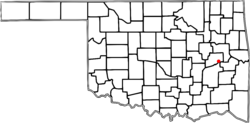Eufaula, Oklahoma
| Eufaula, Oklahoma | |
|---|---|
| City | |
| Motto: "Where Pride Creates Progress" | |
 Location of Eufaula shown in Oklahoma |
|
| Location in the United States | |
| Coordinates: 35°17′31″N 95°35′12″W / 35.29194°N 95.58667°WCoordinates: 35°17′31″N 95°35′12″W / 35.29194°N 95.58667°W | |
| Country | United States |
| State | Oklahoma |
| County | McIntosh |
| Area | |
| • Total | 9.6 sq mi (24.9 km2) |
| • Land | 6.6 sq mi (17.2 km2) |
| • Water | 3.0 sq mi (7.8 km2) |
| Elevation | 617 ft (188 m) |
| Population (2010) | |
| • Total | 2,813 |
| • Density | 397.8/sq mi (153.6/km2) |
| Time zone | Central (CST) (UTC-6) |
| • Summer (DST) | CDT (UTC-5) |
| ZIP codes | 74432, 74461 |
| Area code(s) | 539/918 |
| FIPS code | 40-24650 |
| GNIS feature ID | 1092651 |
| Website | cityofeufaulaok.com |
Eufaula is a city in and county seat of McIntosh County, Oklahoma, United States. The population was 2,813 at the 2010 census, an increase of 6.6 percent from 2,639 in 2000. Eufaula is in the southern part of the county, 30 miles (48 km) north of McAlester and 32 miles (51 km) south of Muskogee.
The name "Eufaula" comes from the Eufaula tribe, part of the Muscogee Creek Confederacy. The town and county are within the jurisdiction of the federally recognized Muscogee Creek Nation, descendants of people who removed here from the Southeastern United States in the 1830s.
By 1800, the Creek had a village named Eufala, located on Eufaula Creek, near what later developed as the present site of Talladega, Alabama. It was one of a group called their Upper Creek towns. Pickett's History of Alabama mentions an Indian town, belonging to the Creek, which he calls Eufaulahatche. Little Eufauly is mentioned by one of the historians of this period as early as 1792. Another Upper Creek town called Eufaula was located on the Tallapoosa River; the present town of Dadeville, Alabama developed near there. The Lower Creek had two villages of similar names: Eufaula on the Chattahoochee River, in what later became Henry County, Alabama; and Eufala, located on the east bank of the Chattahoochee River, within the limits of present Quitman County, Georgia.
Since 1832, after the U. S. Government had forced the Creek to move to Indian Territory from their previous home in the Southeastern United States, Eufaula had been a well-known center of the Creek and frequent meeting place. They held pow-wows or Indian conferences in that vicinity during the early days of Creek settlement. In the 1870s G. W. Grayson, then Chief of the Creek, his brother Samuel, George Stidham and other Creek leaders, persuaded the Missouri, Kansas & Texas Railway (later known as KATY) to locate one of its stations at this site. The older Creek village was moved here to take advantage of the railroad.
...
Wikipedia

